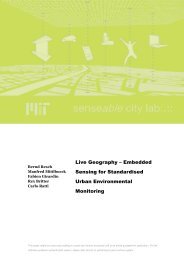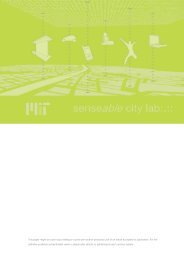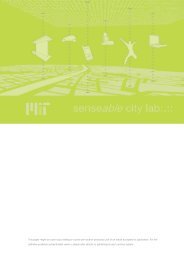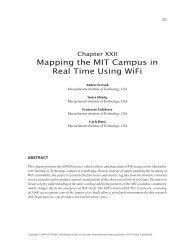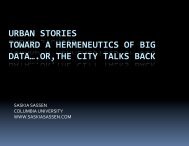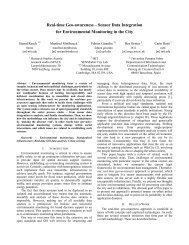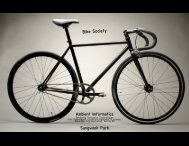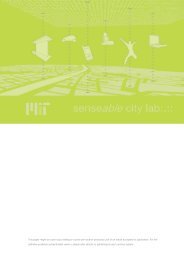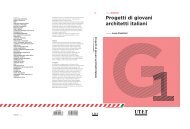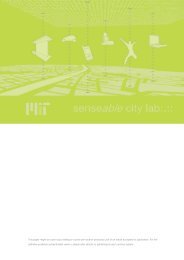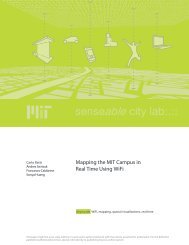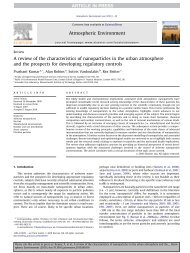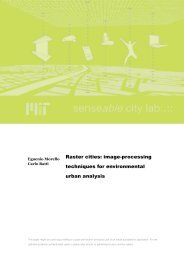Carlo Ratti - MIT SENSEable City Lab
Carlo Ratti - MIT SENSEable City Lab
Carlo Ratti - MIT SENSEable City Lab
You also want an ePaper? Increase the reach of your titles
YUMPU automatically turns print PDFs into web optimized ePapers that Google loves.
Table 3. Lynch’s five visual elements reinterpreted and computed using Image Processing on DEMs and calculations of 3-D<br />
isovists on the maps.<br />
Definitions and examples of visual<br />
elements from Lynch (1960)<br />
Isovist analysis on DEMs<br />
paths<br />
! channels for potential movement (p. 47)<br />
! strong visual character<br />
! kinesthetic quality<br />
! the destination toward which it goes, clear<br />
focuses of origin and destination<br />
Examples:<br />
Main streets and boulevards<br />
Questions:<br />
What is its rhythm Does it present some symmetry or reversibility in both<br />
directions<br />
2-D isovist analysis<br />
(on static and motional views)<br />
! compute longest axial lines<br />
! compute lines of high integration<br />
! verify the sense of motion along the<br />
path; the dynamic shaping of the<br />
movement lines will give its identity and<br />
will produce a continuous experience over<br />
time.<br />
! verify the visibility of the focus along<br />
the street. The continuity of the view is a<br />
characteristic of a clear position in a place<br />
for the observer.<br />
3-D isovist analysis<br />
! count on a pixel per pixel basis the<br />
number of visible voxels along the path,<br />
in order to establish a constant visual<br />
recurrence of built masses.<br />
nodes<br />
! Lynch distinguishes two types of nodes: at<br />
major intersections and those characterised<br />
by concentration with a thematic activity<br />
! clear shape<br />
! key points in way-finding<br />
! contribute to the sense of orientation in the<br />
city<br />
! points with crucial route choices<br />
! nodes with strong visual character,<br />
distinctive in their surroundings and<br />
intensifying some of their characteristics<br />
(p. 77)<br />
Examples:<br />
The central square, the park, a place of<br />
urbanity, where more functions happen<br />
simultaneously<br />
Questions:<br />
Does such a space have a sufficiently strong identity to contain and promote these<br />
functions<br />
2-D isovist analysis<br />
(on static views)<br />
! verify homogeneity or fragmentation of<br />
the boundaries:<br />
- concave shaped nodes (star shaped) and<br />
proximity to highly integrated axial lines<br />
- convex shaped nodes (compact shaped)<br />
! compute area to perimeter ratio<br />
! compute mean isovist length<br />
! compute circularity (Benedikt, 1979)<br />
! compute entropy (Turner et al, 2001)<br />
3-D isovist analysis<br />
/<br />
districts<br />
! clear edges of districts<br />
Examples:<br />
Neighbourhoods with clear boundaries and<br />
with strong character and containing similar<br />
urban functions<br />
Questions:<br />
Is this district coherent Has it a clear structure<br />
2-D isovist analysis<br />
(on motional views)<br />
! verify the homogeneity or the<br />
fragmentation of the boundaries<br />
! for describing the internal character of<br />
districts, verify the uniform distribution of<br />
isovists values, in particular the length of<br />
average radials<br />
! for understanding the external character<br />
of districts, verify if the supposed<br />
boundary pixels of a district act as paths or<br />
as edges<br />
3-D isovist analysis<br />
! compute the number of visible voxels<br />
that appear on each pixel of open space<br />
and verify if its distribution reveals<br />
some homogeneity on a larger scale of<br />
20



